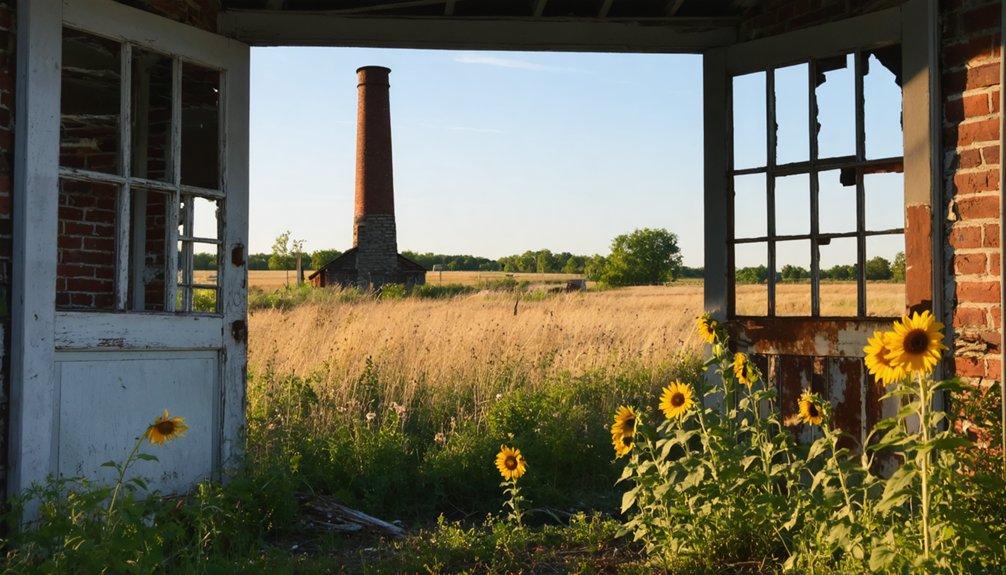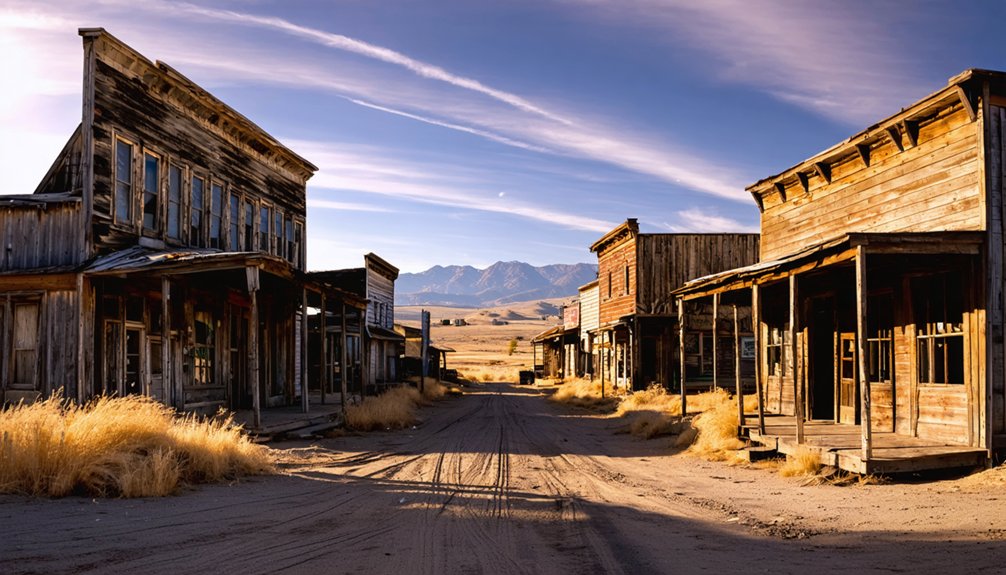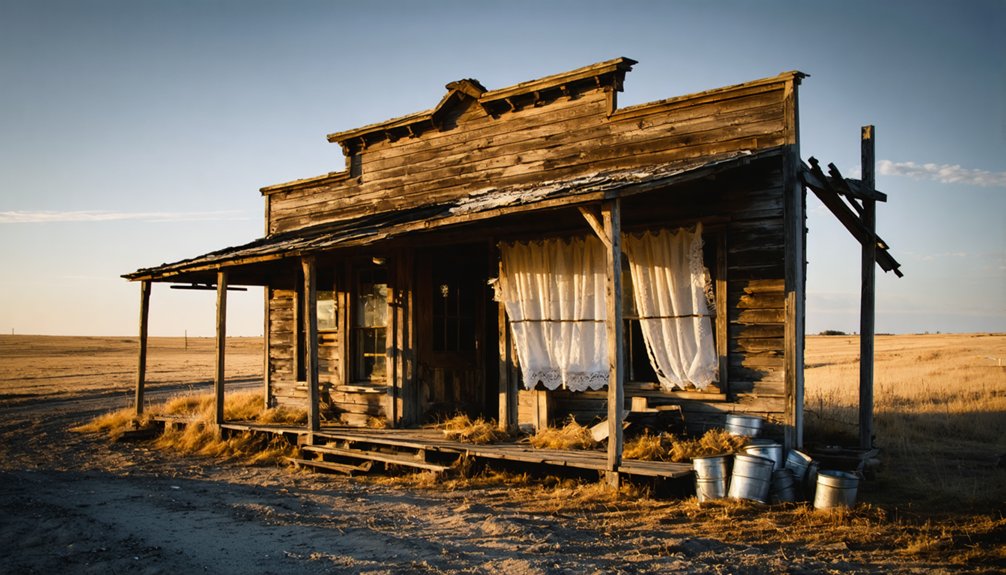You’ll find Nerve City’s ruins tucked away in South Dakota’s Black Hills, where gold fever once drew enthusiastic prospectors in the 1870s. This former mining settlement started with the Gorman brothers’ ambitious mines and grew into a close-knit frontier community complete with churches, schools, and boarding houses. While the town couldn’t survive the eventual depletion of its gold deposits, its weathered buildings and scattered mining remnants still whisper tales of Black Hills boom days.
Key Takeaways
- Nerve City emerged during the 1874 Black Hills gold rush as a mining settlement, centered around operations established by the Gorman brothers.
- The town featured a close community of miners and families living in cabins and boarding houses, with local stores and schools.
- Lack of railroad access and declining mineral deposits led to Nerve City’s economic downfall in the early 1900s.
- Today, Nerve City exists as ruins with weathered buildings, crumbling foundations, and scattered mining equipment reclaimed by prairie grass.
- Visitors can access the ghost town from Spokane Creek Campground via a 15-minute hike, but must obtain proper permissions first.
The Birth of a Mining Settlement
When the Black Hills gold rush erupted in 1874, you wouldn’t have guessed that a small discovery near present-day Lead, South Dakota would transform into one of America’s most significant mining operations.
The Gorman brothers arrived from Canada in 1876 and established two major mines, setting the foundation for what would become Silver City.
The rush started with simple mining techniques like placer mining in French Creek and Whitewood Creek, where prospectors sought their fortunes in the frigid waters.
Early miners armed with picks and shovels worked the creeks until the easy gold was depleted.
Life in Early Nerve City
Life in early Nerve City mirrored the resilient spirit of Black Hills mining settlements, where you’d find a tight-knit community bound by the daily rhythms of mine work and frontier living.
You’d see families gathering at the local church or community hall for social events, from traveling shows to spirited rodeos that brought everyone together.
Like many settler communities, their dreams of new lives and prosperity drew them to establish roots in this frontier town.
While housing wasn’t fancy – mostly simple cabins and boarding houses – you’d witness neighbors helping neighbors through harsh winters and challenging times.
Simple dwellings housed resilient souls who understood survival meant lending a helping hand through winter’s bitter bite.
Local stores and cafes kept supplies flowing, while educational initiatives took root as schools sprung up to serve miners’ children.
The railroad’s presence meant you could count on steady connections to larger markets, while community gatherings at social halls helped maintain spirits through the boom-and-bust cycles of mining life.
The town prospered with two busy hotels serving travelers and temporary residents during its peak years.
Mining Operations and Economic Growth
During the Black Hills gold rush of 1875, you’d witness Nerve City’s mining operations transform from simple placer mining into a sophisticated industry that shaped the region’s destiny.
As mining technology advanced, you’d see the introduction of innovative extraction methods, including the revolutionary cyanidization process that boosted gold recovery rates considerably.
The town’s economic sustainability depended heavily on the constant evolution of mining practices. You’d find miners adopting compressed air locomotives and advanced milling equipment to tackle low-grade ore more efficiently.
These improvements created numerous jobs and attracted substantial investment to the area. The development of infrastructure and establishment of regulatory frameworks in the 1970s helped manage operations more effectively, though you’d also notice increasing attention being paid to environmental concerns as the industry matured.
Transportation and Railroad Connections
While Nerve City’s isolation ultimately contributed to its downfall, you’d find the town’s transportation story reveals the essential role that rail connections played in the fate of Black Hills settlements.
During the region’s railroad expansion of the 1880s-1900s, major lines bypassed this small settlement, instead favoring established mining centers like Deadwood and Rapid City.
You can imagine the transportation challenges faced by Nerve City’s residents, who likely relied on wagon roads and stagecoaches to move goods and people. The town’s distance from western South Dakota made accessing resources particularly difficult.
Without a depot to serve as a crucial communication hub or rail sidings for grain storage, the town couldn’t compete with rail-connected neighbors. In contrast, cities like Aberdeen prospered by having nine rail lines serving their communities.
Like many Black Hills communities that missed the iron horse, Nerve City’s chances of long-term survival diminished as railroad towns flourished.
The Beginning of the End
As you’d expect in any mining town, Nerve City’s fate hung by a thread once the mines began to play out and mineral extraction slowed to a halt.
Without a railroad connection to diversify the economy, the town couldn’t sustain itself through other industries, and families started packing up their belongings.
Like many of the Black Hills ghost towns, the community faced economic shifts that proved insurmountable.
You could feel the life draining from the community as shops closed their doors, miners sought work elsewhere, and the once-bustling streets grew quiet. The decline mirrored what happened to Mystic’s timber industry, which eventually led to that town’s abandonment.
Mining Operations Cease
The depletion of high-grade ore deposits in Nerve City’s mines marked the beginning of an inevitable decline by the early 1900s, signaling the end of an era that had defined the region’s identity.
You’d have seen the mining decline accelerate as production costs soared and rich mineral veins ran dry. Even with technological advances like cyanidization boosting gold recovery rates to 94%, economic factors proved too challenging to overcome.
While some operations tried to adapt through temporary cessation permits and diversification into timber production, the writing was on the wall. The area’s decline mirrored the broader Black Hills region, where illegal prospectors settled in defiance of the 1868 treaty.
By 2002, even the mighty Homestake Mine in nearby Lead, which had operated for an impressive 126 years, finally shut its doors.
The days of Nerve City’s prosperous mining operations were over.
Railroad Service Declines
Following the decline in mining activity, railroad service to Nerve City began its own downward spiral in the post-World War II era.
You’ll find the town’s railroad history mirrors what happened across South Dakota, as automobiles and trucks transformed local transportation. The last passenger train in South Dakota made its final run in 1969. The freedom of the open road proved irresistible, and the once-vital rail lines couldn’t compete.
These transportation shifts hit Nerve City particularly hard:
- Passenger service dwindled as folks chose their own cars over train schedules
- Freight operations became too costly to maintain on the branch line
- The railroad depot, once the town’s lifeline, stood increasingly quiet
Population Exodus Begins
When Nerve City’s economic foundations crumbled in the late 1950s, you’d witness the heartbreaking start of its transformation into a ghost town.
The first signs of population decline emerged as businesses shuttered their doors and farms struggled to stay afloat. You’d see your neighbors packing up their lives, heading to larger cities where jobs and opportunities beckoned.
Without steady income, families couldn’t justify staying. The younger folks left first, seeking education and work elsewhere, leaving behind an aging community.
As economic factors worsened, even the most dedicated residents faced tough choices. Essential services began disappearing – schools closed, shops went dark, and the once-bustling streets grew quiet.
The town’s spirit dimmed as each departure weakened the tight-knit social fabric that had defined Nerve City for generations.
What Remains Today

Visitors exploring Nerve City today will find a haunting blend of weathered buildings and natural reclamation.
Prairie grasses push through crumbling foundations while a few roofless structures stand defiantly against time’s relentless march. The structural decay tells a silent story of the town’s mining glory days, though local preservationists work to protect key artifacts and buildings from complete dissolution.
- The old church still maintains its weathered bell tower, a landmark visible across the empty fields where Main Street once bustled.
- You’ll discover mining equipment scattered throughout, slowly rusting into the landscape but protected by preservation ordinances.
- The former general store’s foundation offers a perfect vantage point for photographers seeking to capture the town’s ethereal atmosphere.
Feel free to explore these remnants of frontier life, but tread carefully – these fragile ruins deserve your respect.
Legacy in Black Hills History
Beyond these weathered ruins, Nerve City holds a deeper place in Black Hills history as part of the transformative 1874 gold rush era.
You’ll find its story woven into the complex tapestry of boom-and-bust mining towns that reshaped this sacred landscape, forever altering both indigenous heritage and the natural environment.
Like many Black Hills settlements, Nerve City embodied the collision between gold fever and broken treaties with the Lakota Sioux.
While prospectors chased their dreams of striking it rich, their presence left lasting environmental consequences through extensive mining operations.
Today, Nerve City’s legacy serves as a reminder of the region’s contested past, where the rush for mineral wealth challenged indigenous rights and transformed pristine wilderness into a landscape marked by human ambition.
Visiting the Ghost Town Site

You’ll find visiting Nerve City requires careful navigation through Lawrence County’s rural landscape north of Balmoral, as the site lacks clear markers or maintained roads.
Before attempting to reach the barren location, it’s crucial to secure landowner permissions and check local regulations since access points aren’t well-defined.
The best approach is to contact the Lawrence County Historical Society for guidance on viewing what remains of this obscure Black Hills ghost town.
Current Site Access Details
The journey to Nerve City begins at Spokane Creek Campground, where a well-worn trail leads adventurers on a 15-minute hike through the Black Hills forest to this fascinating ghost town’s remains.
You’ll find ample parking options at the campground, with trail conditions that accommodate both families and solo explorers year-round.
- Park your vehicle at Spokane Creek Campground and head north on the marked trail
- Follow the uphill path for roughly 15 minutes through forested terrain
- Watch for ruins, foundations, and three standing structures that mark your arrival
The site’s accessibility from Iron Mountain Road 16A makes it an ideal stop for freedom-seeking explorers.
While winter months can bring challenging conditions, the warmer seasons offer perfect opportunities to discover this remnant of South Dakota’s mining heritage.
Safety and Legal Considerations
While exploring Nerve City’s haunting ruins offers a memorable journey into South Dakota’s mining past, visitors must prioritize both personal safety and legal obligations.
You’ll need to watch for deteriorating structures, unstable ground, and sudden weather changes that can make exploration dangerous. Safety precautions include wearing sturdy boots, carrying first-aid supplies, and letting someone know your plans.
Before heading out, check the legal restrictions that govern site access. You’ll need proper permissions if the area falls within private property or mining claims.
Remember that removing artifacts or disturbing structures isn’t just illegal – it’s destroying pieces of history. Stay on marked paths to protect both yourself and the site’s integrity.
If you’re venturing into this remote area, bring plenty of water and navigation tools, as cell service is unreliable.
Best Viewing Locations
Finding your way to Nerve City requires careful planning, as this vanished mining settlement lies roughly 1,500 feet north of Balmoral’s quiet countryside.
You’ll find the best views during early morning or late afternoon when the sun casts revealing shadows across the landscape, highlighting subtle depressions where buildings once stood.
- Position yourself on higher ground facing east during sunrise for ideal photographic techniques that capture any remaining foundation traces.
- Scout the perimeter during spring or fall when vegetation is sparse, making ground features more visible.
- Set up near the tree line at dawn or dusk for wildlife observations, as deer and native birds frequently pass through the former townsite.
The open fields where Nerve City once thrived now offer a peaceful reminder of the Black Hills’ dynamic mining heritage.
Frequently Asked Questions
What Was the Origin of the Unusual Name “Nerve City”?
Like David facing Goliath’s challenge, you’ll find the name origin stems from local folklore about miners who needed “nerve” to face dangerous work conditions daily in this tough frontier town.
Were There Any Notable Crimes or Lawlessness Reported in Nerve City?
You won’t find documented crime statistics or law enforcement records from this tiny outpost. While regional towns had their share of lawlessness, there’s no evidence of notable criminal activity here specifically.
What Was the Peak Population of Nerve City During Its Boom Years?
Like many mining industry boom towns that spawned ghost stories, you’d be interested to know the exact peak population isn’t documented, but estimates suggest several hundred residents during its height around the turn-of-the-century.
Did Any Famous Historical Figures Ever Visit or Live in Nerve City?
You won’t find any famous visitors in this town’s history – there’s no documented evidence of prominent historical figures ever stopping by or settling in this brief-lived mining outpost.
Were There Any Major Natural Disasters That Affected Nerve City’s Development?
While 80% of Black Hills towns faced natural challenges, you won’t find records of specific disasters hitting Nerve City. Though regional flood impacts and drought effects tested settlers, they weren’t decisive in its fate.
References
- https://blackhillsvisitor.com/learn/owanka/
- https://www.youtube.com/watch?v=Glucs_Rq8Xs
- https://www.powderhouselodge.com/black-hills-attractions/fun-attractions/ghost-towns-of-western-south-dakota/
- https://www.sdhspress.com/journal/south-dakota-history-2-2/some-black-hills-ghost-towns-and-their-origins/vol-02-no-2-some-black-hills-ghost-towns-and-their-origins.pdf
- https://www.sdpb.org/rural-life-and-history/2023-08-21/some-black-hills-ghost-towns-and-their-origins
- https://www.youtube.com/watch?v=_0WNYsFLSLA
- https://www.blackhillsbadlands.com/blog/post/old-west-legends-mines-ghost-towns-route-reimagined/
- https://en.wikipedia.org/wiki/List_of_ghost_towns_in_South_Dakota
- https://icatchshadows.com/okaton-and-cottonwood-a-photographic-visit-to-two-south-dakota-ghost-towns/
- https://www.youtube.com/watch?v=ShL4wa4Vvvw



